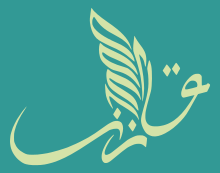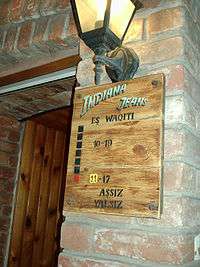Tatar language
| Tatar | |
|---|---|
| татар теле | |
| Native to | Russia, other post-Soviet states |
| Ethnicity | Tatars |
Native speakers |
5.2 million (2015)[1] (may include some L2 speakers) |
|
Turkic
| |
| Cyrillic | |
| Official status | |
Official language in | |
| Regulated by | Institute of Language, Literature and Arts of the Academy of Sciences of the Republic of Tatarstan |
| Language codes | |
| ISO 639-1 |
tt |
| ISO 639-2 |
tat |
| ISO 639-3 |
tat – inclusive codeIndividual code: sty – Siberian Tatar |
| Glottolog |
tata1255[2] |
| Linguasphere |
44-AAB-be |
The Tatar language (Tatar: татар теле, татарча) is a Turkic language spoken by Tatars mainly located in modern Tatarstan, Bashkortostan (European Russia), as well as Siberia. It should not be confused with the Crimean Tatar language which is closely related, but belongs to another, the Cuman subgroup of the Kipchak languages.
Geographic distribution
The Tatar language is spoken in Russia (about 5.3 million people), Ukraine, China, Finland, Turkey, Uzbekistan, the United States of America, Romania, Azerbaijan, Israel, Kazakhstan, Georgia, Lithuania, Latvia, and other countries. There are more than 7 million speakers of Tatar in the world.
Tatar is also native for several thousand Maris. Mordva's Qaratay group also speak a variant of Kazan Tatar.
In the 2010 census, 69% of Russian Tatars who responded to the question about language ability claimed a knowledge of the Tatar language.[3] In Tatarstan, 93% of Tatars and 3.6% of Russians did so. In neighbouring Bashkortostan, 67% of Tatars, 27% of Bashkirs, and 1.3% of Russians did.[4]
Official status
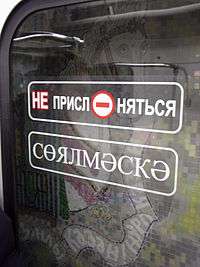
Tatar, along with Russian, is the official language of the Republic of Tatarstan. The official script of Tatar language is based on the Cyrillic script with some additional letters. The Republic of Tatarstan passed a law in 1999, which came into force in 2001, establishing an official Tatar Latin alphabet. A Russian federal law overrode it in 2002, making Cyrillic the sole official script in Tatarstan since. Unofficially, other scripts are used as well, mostly Latin and Arabic. All official sources in Tatarstan must use Cyrillic on their websites and in publishing. In other cases, where Tatar has no official status, the use of a specific alphabet depends on the preference of the author.
The Tatar language was made a de facto official language in Russia in 1917, but only within the Tatar Autonomous Soviet Socialist Republic. Tatar is also considered to have been the official language in the short-lived Idel-Ural State, briefly formed during the Russian Civil War.
The usage of Tatar declined from during the 20th century. By the 1980s, the study and teaching of Tatar in the public education system was limited to rural schools. However, Tatar-speaking pupils had little chance of entering university because higher education was available in Russian almost exclusively.
As of 2001 Tatar was considered a potentially endangered language while Siberian Tatar received "endangered" and "seriously endangered" statuses, respectively.[5] Higher education in Tatar can only be found in Tatarstan, and is restricted to the humanities. In other regions Tatar is primarily a spoken language and the number of speakers as well as their proficiency tends to decrease. Tatar is popular as a written language only in Tatar-speaking areas where schools with Tatar language lessons are situated. On the other hand, Tatar is the only language in use in rural districts of Tatarstan.
Since 2017 Tatar language classes are no longer mandatory in the schools of Tatarstan.[6] According to the opponents of this change, it will further endanger the Tatar language and is a violation of the Tatarstan Constitution which stipulates the equality of Russian and Tatar languages in the republic.[7][8]
Dialects of Tatar
There are two main dialects of Tatar:
- Central or Middle (Kazan)
- Western (Mişär or Mishar)
All of these dialects also have subdivisions. Significant contribution to the study of the Tatar language and its dialects, were made by a scientist Gabdulkhay Akhatov, who is considered to be the founder of the modern Tatar dialectological school.
Spoken idioms of Siberian Tatars, which differ significantly from the above two, are often considered as the third dialect group of Tatar by some, but as an independent language on its own by others.
Central or Middle
The Central or Middle dialectal group is spoken in Kazan and most of Tatarstan and is the basis of the standard literary Tatar language.
Mişär
In the Western (Mişär) dialect ç is pronounced [tɕ] (southern or Lambir Mişärs) and as [ts] (northern Mişärs or Nizhgars). C is pronounced [dʑ]. There are no differences between v and w, q and k, g and ğ in the Mişär dialect. (The Cyrillic alphabet doesn't have special letters for q, ğ and w, so Mişär speakers have no difficulty reading Tatar written in Cyrillic.)
This is the dialect spoken by the Tatar minority of Finland.
Siberian Tatar
Two main isoglosses that characterize Siberian Tatar are ç as [ts] and c as [j], corresponding to standard [ɕ] and [ʑ]. There are also grammatical differences within the dialect, scattered across Siberia.[9]
Many linguists claim the origins of Siberian Tatar dialects are actually independent of Volga–Ural Tatar; these dialects are quite remote both from Standard Tatar and from each other, often preventing mutual comprehension. The claim that this language is part of the modern Tatar language is typically supported by linguists in Kazan and denounced by Siberian Tatars.
Over time, some of these dialects were given distinct names and recognized as separate languages (e.g. the Chulym language) after detailed linguistic study. A brief linguistic analysis shows that many of these dialects exhibit features which are quite different from the Volga–Ural Tatar varieties, and should be classified as Turkic varieties belonging to several sub-groups of the Turkic languages, distinct from Kipchak languages to which Volga–Ural Tatar belongs.
Phonology
Vowels
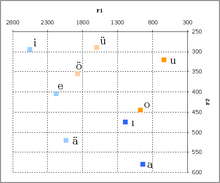
There exist several interpretations of the Tatar vowel phonemic inventory. In total Tatar has nine or ten native vowels, and three or four loaned vowels (mainly in Russian loanwords).[10][11]
According to Baskakov (1988) Tatar has only two vowel heights, high and low. There are two low vowels, front and back, while there are eight high vowels: front and back, round (R+) and unround (R-), normal and short (or reduced).[10]
| Front | Back | ||||
|---|---|---|---|---|---|
| R- | R+ | R- | R+ | ||
| High | Normal | i | ü | ï | u |
| Short | e | ö | ë | o | |
| Low | ä | a | |||
Poppe (1963) proposed a similar yet slightly different scheme with a third, higher mid, height, and with nine vowels.[10]
| Front | Back | |||
|---|---|---|---|---|
| R- | R+ | R- | R+ | |
| High | i | ü | u | |
| Higher Mid | e | ö | ï | o |
| Low | ä | a | ||
According to Makhmutova (1969) Tatar has three vowel heights: high, mid and low, and four tongue positions: front, front-central, front-back and back.[10]
| Front | Central | Back | ||||||
|---|---|---|---|---|---|---|---|---|
| Front | Back | |||||||
| R- | R+ | R- | R+ | R- | R+ | R- | R+ | |
| High | i | ü | ï | u | ||||
| Mid | e | ö | ë | o | ||||
| Low | ä | a | ||||||
The mid back unrounded vowel ''ë is usually transcribed as ı, though it differs from the corresponding Turkish vowel.
The tenth vowel ï is realized as the diphthong ëy (IPA: [ɯɪ]), which only occurs word-finally, but it has been argued to be an independent phoneme.[10][11]
Phonetically, the native vowels are approximately thus (with the Cyrillic letters and the usual Latin romanization in angle brackets):
| Front | Back | |||
|---|---|---|---|---|
| R- | R+ | R- | R+ | |
| High | и ⟨i⟩ [i] |
ү ⟨ü⟩ [y~ʉ] |
ый ⟨ıy⟩ [ɯɪ] |
у ⟨u⟩ [u] |
| Mid | э, е ⟨e⟩ [ĕ~ɘ̆] |
ө ⟨ö⟩ [ø̆~ɵ̆] |
ы ⟨ı⟩ [ɤ̆~ʌ̆] |
о ⟨o⟩ [ŏ] |
| Low | ә ⟨ä⟩ [æ~a] |
а ⟨a⟩ [ɑ] |
||
In polysyllabic words, the front-back distinction is lost in reduced vowels: all become mid-central.[10] The mid reduced vowels in an unstressed position are frequently elided, as in кеше keşe [kĕˈʃĕ] > [kʃĕ] 'person', or кышы qışı [qɤ̆ˈʃɤ̆] > [qʃɤ̆] '(his) winter'..[11] Low back /ɑ/ is rounded [ɒ] in the first syllable and after [ɒ], but not in the last, as in бала bala [bɒˈlɑ] 'child', балаларга balalarğa [bɒlɒlɒrˈʁɑ] 'to children'.[11] In Russian loans there are also [ɨ], [ɛ], [ɔ], and [ä], written the same as the native vowels: ы, е/э, о, а respectively.[11]
Historical shifts
Historically, the Old Turkic mid vowels have raised from mid to high, whereas the Old Turkic high vowels have become the Tatar reduced mid series. (The same shifts have also happened in Baskir.)[12]
| Vowel | Old Turkic | Turkish | Kazakh | Tatar | Bashkir | Gloss |
|---|---|---|---|---|---|---|
| *e | *et | et | et | it | it | 'meat' |
| *ö | *söz | söz | söz | süz | hüź [hyθ] | 'word' |
| *o | *sol | sol | sol | sul | hul | 'left' |
| *i | *it | it | it | et | et | 'dog' |
| *ï | *qïz | kız | qız | qëz [qɤ̆z] | qëź [qɤ̆θ] | 'girl' |
| *u | *qum | kum | qum | qom | qom | 'sand' |
| *ü | *kül | kül | kül | köl | köl | 'ash' |
Consonants
| Labial | Labio- velar |
Dental | Post- alveolar |
Palatal | Velar | Uvular | Glottal | ||
|---|---|---|---|---|---|---|---|---|---|
| Nasals | м ⟨m⟩ /m/ |
н ⟨n⟩ /n/ |
ң ⟨ñ⟩ /ŋ/ |
||||||
| Plosives | Voiceless | п ⟨p⟩ /p/ |
т ⟨t⟩ /t/ |
к ⟨k⟩ /k/ |
къ ⟨q⟩ /q/‡ |
э/ь ⟨’⟩ /ʔ/* | |||
| Voiced | б ⟨b⟩ /b/ |
д ⟨d⟩ /d/ |
г ⟨g⟩ /ɡ/ |
||||||
| Affricates | Voiceless | ц ⟨ts⟩ /ts/*† |
ч ⟨ç⟩ /tɕ/*† |
||||||
| Voiced | җ ⟨c⟩ /dʑ/† |
||||||||
| Fricatives | Voiceless | ф ⟨f⟩ /f/* |
с ⟨s⟩ /s/ |
ш ⟨ş⟩ /ʃ/ |
ч ⟨ç⟩ /ɕ/ |
х ⟨x⟩ /χ/ |
һ ⟨h⟩ /h/* | ||
| Voiced | в ⟨v⟩ /v/* |
з ⟨z⟩ /z/ |
ж ⟨j⟩ /ʒ/* |
җ ⟨c⟩ /ʑ/ |
гъ ⟨ğ⟩ /ʁ/‡ |
||||
| Trill | р ⟨r⟩ /r/ |
||||||||
| Approximants | у/ү/в ⟨w⟩ /w/ |
л ⟨l⟩ /l/ |
й ⟨y⟩ /j/ |
||||||
- Notes
- ^* The phonemes /v/, /ts/, /tɕ/, /ʒ/, /h/, /ʔ/ are only found in loanwords. /f/ occurs more commonly in loanwords, but is also found in native words, e.g. yafraq 'leaf'.[11] /v/, /ts/, /tɕ/, /ʒ/ may be substituted with the corresponding native consonants /w/, /s/, /ɕ/, /ʑ/ by some Tatars.
- ^† /dʑ/ and /tɕ/ are the dialectal Western (Mişär) pronunciations of җ ⟨c⟩ /ʑ/ and ч ⟨ç⟩ /ɕ/, the latter are in the literary standard and in the Central (Kazan) dialect. /ts/ is the variant of ч ⟨ç⟩ /ɕ/ as pronounced in the Eastern (Siberian) dialects and some Western (Mişär) dialects. Both /tɕ/ and /ts/ are also used in Russian loanwords (the latter written ц).
- ^‡ /q/ and /ʁ/ are usually considered allophones of /k/ and /ɡ/ in the environment of back vowels, so they never written in the Tatar Cyrillic orthography in native words, and only rarely in loanwords with къ and гъ. However, /q/ and /ʁ/ also appear before front /æ/ in Perso-Arabic loanwords which may indicate the phonemic status of these uvular consonants.
Palatalization
Tatar consonants usually undergo slight palatalization before front vowels. However, this allophony is not significant and does not constitute a phonemic status. This differs from Russian where palatalized consonants are not allophones but phonemes on their own. There are a number of Russian loanwords which have a palatalized consonants in Russian and thus written the same in Tatar (often with the "soft sign" ь). The Tatar standard pronunciation also requires palatalization in such loanwords, however, some Tatar may pronounce them non-palatalized.
Syllables
In native words there are six types of syllables (Consonant, Vowel, Sonorant):
- V (ı-lıs, u-ra, ö-rä)
- VC (at-law, el-geç, ir-kä)
- CV (qa-la, ki-ä, su-la)
- CVC (bar-sa, sız-law, köç-le, qoş-çıq)
- VSC (ant-lar, äyt-te, ilt-kän)
- CVSC (tört-te, qart-lar, qayt-qan)
Loanwords allow other types: CSV (gra-mota), CSVC (käs-trül), etc.
Prosody
Stress is usually on the final syllable. However, some suffixes cannot be stressed, so the stress shifts to the syllable before that suffix, even if the stressed syllable is the third or fourth from the end. A number of Tatar words and grammatical forms have the natural stress on the first syllable. Loanwords, mainly from Russian, usually preserve their original stress (unless the original stress is on the last syllable, in such a case the stress in Tatar shifts to suffixes as usual, e.g. sovét > sovetlár > sovetlarğá).
Phonetic alterations
Tatar phonotactics dictate many pronunciation changes which are not reflected in the orthography.
- Unrounded vowels ı and e become rounded after o or ö:
- коры/qorı > [qoro]
- борын/borın > [boron]
- көзге/közge > [közgö]
- соры/sorı > [soro]
- Nasals are assimilated to the following stops:
- унбер/unber > [umber]
- менгеч/mengeç > [meñgeç]
- Stops are assimilated to the preceding nasals (this is reflected in writing):
- урманнар/urmannar ( < urman + lar)
- комнар/komnar ( < kom + lar)
- Voicing may also undergo assimilation:
- күзсез/küzsez > [küssez]
- Unstressed vowels may be syncopated or reduced:
- урыны/urını> [urnı]
- килене/kilene > [kilne]
- Vowels may also be elided:
- кара урман/qara urman > [qarurman]
- килә иде/kilä ide > [kiläyde]
- туры урам/turı uram > [tururam]
- була алмын/bula almım > [bulalmım]
- In consonant clusters longer than two phones, ı or e (whichever is dictated by vowel harmony) is inserted into speech as an epenthetic vowel.
- банк/bank > [bañqı]
- Final consonant clusters are simplified:
- артист/artist > [artis]
- Final devoicing is also frequent:
- табиб/tabib > [tabip]
Grammar
Like other Turkic languages, Tatar is an agglutinative language.
- Nominative -
- Accusative: -ны/-не, -н
- Possessive: -ның/-нең
- Dative: -га/-гә, -ка/-кә, -а/-ә, -на/-нә
- Locative: -да/-дә, -та/-тә, -нда/-ндә
- Ablative: -дан/-дән, -тан/-тән, -нан/-нән, -ннан/-ннән
- Nominative: -лар/-ләр, -нар/-нәр
- Accusative: -ларны
- Possessive: -ларның
- Dative: -ларга
- Locative: -ларда
- Ablative: -лардан
Plural
- After vowels, consonants, hard: -lar (bala-lar, abí-lar, kitap-lar, qaz-lar, malay-lar, qar-lar, ağaç-lar)
- After vowels, consonants, soft: -lär (äni-lär, sölge-lär, däftär-lär, kibet-lär, süz-lär, bäbkä-lär, mäktäp-lär, xäref-lär)
- After nasals, hard: -nar (uram-nar, urman-nar, tolım-nar, moñ-nar, tañ-nar, şalqan-nar)
- After nasals, soft: -när (ülän-när, keläm-när, çräm-när, iñ-när, ciñ-när, isem-när)
Declension of pronouns
| Case | Singular | Plural | ||||
|---|---|---|---|---|---|---|
| Nominative | мин min | син sin | ул ul | без bez | сез sez | алар alar |
| Genitive | минем minem | синең sineñ | аның anıñ | безнең bezneñ | сезнең sezneñ | аларның alarnıñ |
| Dative | миңа miña | сиңа siña | аңа aña | безгә bezgä | сезгә sezgä | аларга alarğa |
| Accusative | мине mine | сине sine | аны anı | безне bezne | сезне sezne | аларны alarnı |
| Locative | миндә mindä | синдә sindä | анда anda | бездә bezdä | сездә sezdä | аларда alarda |
| Ablative | миннән minnän | синнән sinnän | аннан annan | бездән bezdän | сездән sezdän | алардан alardan |
| Case | Singular | Plural | ||
|---|---|---|---|---|
| Case | "This" | "That" | "These" | "Those" |
| Nominative | бу bu | шул şul | болар bolar | шулар şular |
| Genitive | моның monıñ | шуның şunıñ | боларның bolarnıñ | шуларның şularnıñ |
| Dative | моңа moña | шуңа şuña | боларга bolarğa | шуларга şularğa |
| Accusative | моны monı | шуны şunı | боларны bolarnı | шуларны şularnı |
| Locative | монда monda | шунда şunda | боларда bolarda | шуларда şularda |
| Ablative | моннан monnan | шуннан şunnan | болардан bolardan | шулардан şulardan |
| Case | Who? | What? |
|---|---|---|
| Nominative | кем kem | нәрсә närsä |
| Genitive | кемнең kemneñ | нәрсәнең närsäneñ |
| Dative | кемгә kemgä | нәрсәгә närsägä |
| Accusative | кемне kemne | нәрсәне närsäne |
| Locative | кемдә kemdä | нәрсәдә närsädä |
| Ablative | кемнән kemnän | нәрсәдән närsädän |
Writing system
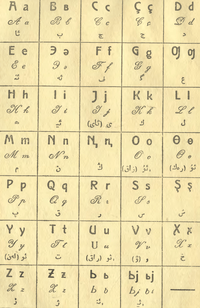
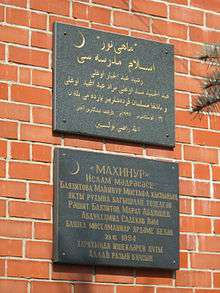
During its history Tatar has been written in Arabic, Latin and Cyrillic scripts.
Before 1928, Tatar was mostly written with in Arabic script (Иске имля/İske imlâ, "Old orthography", to 1920; Яңа имла/Yaña imlâ, "New orthography", 1920–1928).
During the 19th century Russian Christian missionary Nikolay Ilminsky devised the first Cyrillic alphabet for Tatar. This alphabet is still used by Christian Tatars (Kryashens).
In the Soviet Union after 1928, Tatar was written with a Latin alphabet called Jaᶇalif.
In 1939, in Tatarstan and all other parts of the Soviet Union a Cyrillic script was adopted and is still used to write Tatar. It is also used in Kazakhstan.
The Republic of Tatarstan passed a law in 1999 that came into force in 2001 establishing an official Tatar Latin alphabet. A Russian federal law overrode it in 2002, making Cyrillic the sole official script in Tatarstan since. In 2004, an attempt to introduce a Latin-based alphabet for Tatar was further abandoned when the Constitutional Court ruled that the federal law of 15 November 2002 mandating the use of Cyrillic for the state languages of the republics of the Russian Federation[14] does not contradict the Russian constitution.[15] In accordance with this Constitutional Court ruling, on 28 December 2004, the Tatar Supreme Court overturned the Tatarstani law that made the Latin alphabet official.[16]
In 2012 the Tatarstan government adopted a new Latin alphabet but with the limited usage (mostly for Romanization).
- Tatar Cyrillic alphabet (1939; the letter order adopted in 1997):
| А а | Ә ә | Б б | В в | Г г | Д д | Е е | Ё ё |
| Ж ж | Җ җ | З з | И и | Й й | К к | Л л | М м |
| Н н | Ң ң | О о | Ө ө | П п | Р р | С с | Т т |
| У у | Ү ү | Ф ф | Х х | Һ һ | Ц ц | Ч ч | Ш ш |
| Щ щ | Ъ ъ | Ы ы | Ь ь | Э э | Ю ю | Я я | |
- Tatar Old Cyrillic alphabet (by Nikolay Ilminsky, 1861; the letters in parenthesis are not used in modern publications):
| А а | Ӓ ӓ | Б б | В в | Г г | Д д | Е е | Ё ё | Ж ж | З з |
| И и | (Іі) | Й й | К к | Л л | М м | Н н | Ҥ ҥ | О о | Ӧ ӧ |
| П п | Р р | С с | Т т | У у | Ӱ ӱ | Ф ф | Х х | Ц ц | Ч ч |
| Ш ш | Щ щ | Ъ ъ | Ы ы | Ь ь | (Ѣѣ) | Э э | Ю ю | Я я | (Ѳѳ) |
- 1999 Tatar Latin alphabet, made official by a law adopted by Tatarstani authorities but annulled by the Tatar Supreme Court in 2004:[16]
| A a | Ə ə | B b | C c | Ç ç | D d | E e | F f |
| G g | Ğ ğ | H h | I ı | İ i | J j | K k | Q q |
| L l | M m | N n | Ꞑ ꞑ | O o | Ɵ ɵ | P p | R r |
| S s | Ş ş | T t | U u | Ü ü | V v | W w | X x |
| Y y | Z z | ’ | |||||
- 2012 Tatar Latin alphabet
| A a | Ä ä | B b | C c | Ç ç | D d | E e | F f |
| G g | Ğ ğ | H h | I ı | İ i | J j | K k | Q q |
| L l | M m | N n | Ñ ñ | O o | Ö ö | P p | R r |
| S s | Ş ş | T t | U u | Ü ü | V v | W w | X x |
| Y y | Z z | ’ | |||||
- Tatar Arabic alphabet (before 1928):
| آ | ا | ب | پ | ت | ث | ج | چ |
| ح | خ | د | ذ | ر | ز | ژ | س |
| ش | ص | ض | ط | ظ | ع | غ | ف |
| ق | ك | گ | نك | ل | م | ن | ه |
| و | ۇ | ڤ | ی | ئ | |||
History
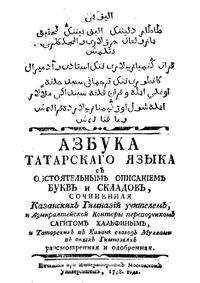
Tatar's ancestors are the extinct Bulgar and Kipchak languages.
The literary Tatar language is based on the Middle Tatar dialect and on the Old Tatar language (İske Tatar Tele). Both are members of the Volga-Ural subgroup of the Kipchak group of Turkic languages, although they also partly derive from the ancient Volga Bulgar language.
Most of the Uralic languages in the Volga River area have strongly influenced the Tatar language,[17] as have the Arabic, Persian and Russian languages.[18]
Crimean Tatar, although similar by name, belongs to another subgroup of the Kipchak languages, usually called Pontic, Cuman or Polovtsian. Unlike Kazan Tatar, Crimean Tatar is heavily influenced by Turkish.
Examples
Universal Declaration of Human Rights, Article 1:
- Cyrillic
Барлык кешеләр дә азат һәм үз абруйлары һәм хокуклары ягыннан тиң бупып туапар. Аларга акыл һәм вөҗдан бирелгән һәм бер-берсенә карата туганнарча мөнасәбәттә булырга тиешләр.
- Romanization
Barlıq keşelär dä azat häm üz abruyları häm xoquqları yağınnan tiñ bulıp tualar. Alarğa aqıl häm wöcdan birelgän häm ber-bersenä qarata tuğannarça mönasäbättä bulırğa tieşlär
See also
Notes
- ↑ Tatar at Ethnologue (18th ed., 2015)
Siberian Tatar at Ethnologue (18th ed., 2015) - ↑ Hammarström, Harald; Forkel, Robert; Haspelmath, Martin, eds. (2017). "Tatar". Glottolog 3.0. Jena, Germany: Max Planck Institute for the Science of Human History.
- ↑ Russian Census 2010. Владение языками населением (in Russian)
- ↑ Russian Census 2010. Владение языками населением наиболее многочисленных национальностей по субъектам Российской Федерации (in Russian)
- ↑ Wurm, S; Unesco. (2001). Atlas of the world's languages in danger of disappearing. Paris: Unesco Pub. ISBN 978-92-3-103798-6.
- ↑ BBC Russia, Без языка: Казань отказалась от обязательных уроков татарского, 01.12.2017
- ↑ БИЗНЕС Online, Татарский язык становится «ящиком Пандоры», 22.09.2017
- ↑ БИЗНЕС Online, Исмагил Хуснутдинов: «Под лозунгом добровольности татарский язык пытаются изгнать из школ», 12.11.2017
- ↑ Information about Siberian Tatar
- 1 2 3 4 5 6 Harrison, K. David; Kaun, Abigail R. (2003). "Vowels and Vowel Harmony in Namangan Tatar". In Holisky, Dee Ann; Tuite, Kevin. Current Trends in Caucasian, East European and Inner Asian Linguistics. pp. 194–198.
- 1 2 3 4 5 6 7 Berta, Árpád (1998). "Tatar and Bashkir". In Johanson, Lars; Csató, Éva Á. The Turkic languages. Routledge. pp. 283–300.
- ↑ Johanson, Lars (1998). "The History of Turkic". In Johanson, Lars; Csató, Éva Á. The Turkic languages. Routledge. p. 92.
- ↑ Pronoun declensions based on or extrapolated from information contained on Грамматика татарского языка
- ↑ Spolsky, Bernard (2004). Language Policy. Cambridge University Press. p. 2. ISBN 978-0-521-01175-4.
- ↑ "Russia court sticks to letter law". BBC News. 16 November 2004. Retrieved 20 February 2012.
- 1 2 "The Tatar language will continue to be written through the Cyrillic alphabet". U.S. English Foundation. February 2005. Archived from the original on 30 April 2011. Retrieved 20 February 2012.
- ↑ Tatar language – Princeton University Archived 13 December 2006 at the Wayback Machine.
- ↑ (in Russian) Татарский язык в Интернете: информация о методах и средствах обучения
Further reading
- Bukharaev, R., & Matthews, D. J. (2000). Historical anthology of Kazan Tatar verse: voices of eternity. Richmond, Surrey: Curzon. ISBN 0-7007-1077-9
- PEN (Organization). (1998). Tatar literature today. Kazan: Magarif Publishers.
- Poppe, N. N. (1963). Tatar manual: descriptive grammar and texts with a Tatar-English glossary. Bloomington: Indiana University.
- (in Russian) Ахатов Г. Х. Татарская диалектология (учебник для студентов вузов). — Казань, 1984.
- (in Russian) Татарская грамматика. В 3-х т. / Гл. ред. М. З. Закиев. — Казань, 1993.
- Gilmetdinova A, Malova I. 'Language education for glocal interaction: English and Tatar.' World Englishes 37(3) 2018;1–11. https://doi.org/10.1111/weng.12324
External links
- (in Russian) Atlas of Tatar dialects
| Tatar edition of Wikipedia, the free encyclopedia |
| Wikivoyage has a travel guide for Tatar phrasebook. |
